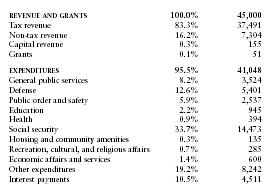Russia - Public finance
Since the breakup of the COMECON and the Soviet Union, trade disruptions and friction between Russia and the governments of the former Soviet republics had led to an enormous expansion of the fiscal deficit. The deficit was financed largely through sales of domestic government securities and borrowing from international financial institutions. Consequently, the government had sharply restrained spending in an attempt to keep the federal budget deficit to under 6% of GDP. Government spending remains about 38% of GDP, but the government has manages to achieve a small surplus. The external debt was estimated to rise about $19 billion in 2003 as a result of higher Ministry of Finance and Eurobond payments.
The US Central Intelligence Agency (CIA) estimates that in 2001 the Russian Federation's central government took in revenues of approximately $45 billion and had expenditures of $43 billion. Overall, the government registered a surplus of approximately $2 billion. External debt totaled $149 billion.
The following table shows an itemized breakdown of government revenues and expenditures. The percentages were calculated from data reported by the International Monetary Fund. The dollar amounts (millions) are based on the CIA estimates provided above.

| REVENUE AND GRANTS | 100.0% | 45,000 |
| Tax revenue | 83.3% | 37,491 |
| Non-tax revenue | 16.2% | 7,304 |
| Capital revenue | 0.3% | 155 |
| Grants | 0.1% | 51 |
| EXPENDITURES | 95.5% | 41,048 |
| General public services | 8.2% | 3,524 |
| Defense | 12.6% | 5,401 |
| Public order and safety | 5.9% | 2,537 |
| Education | 2.2% | 945 |
| Health | 0.9% | 394 |
| Social security | 33.7% | 14,473 |
| Housing and community amenities | 0.3% | 135 |
| Recreation, cultural, and religious affairs | 0.7% | 285 |
| Economic affairs and services | 1.4% | 600 |
| Other expenditures | 19.2% | 8,242 |
| Interest payments | 10.5% | 4,511 |
Comment about this article, ask questions, or add new information about this topic: